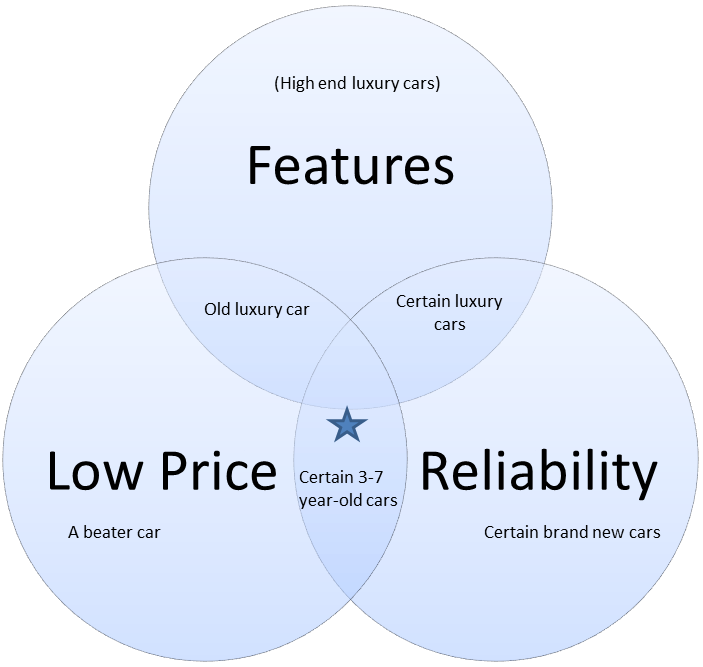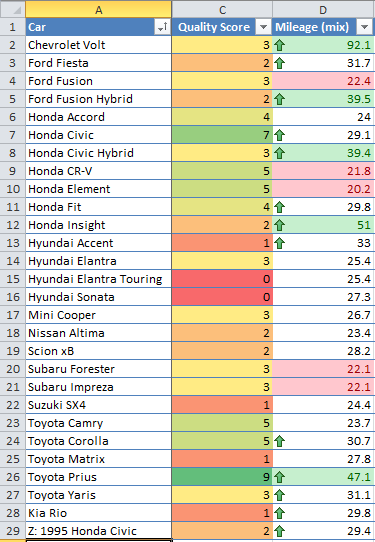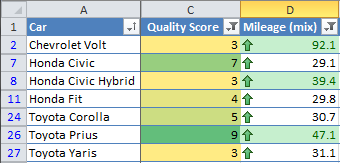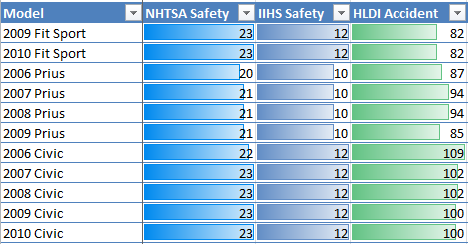Buy a Car With Data
When all you have is a hammer, everything looks like a thumb
Buying a car is an experience most people dread, and avoid. I’m going to go over how I had fun buying a car using data. This way I can see through all the lies “marketing”.
Background
We like reliable steeds
My wife, Kate, and I were perfectly content to drive her car, a 1995 Honda Civic. It never gave us any trouble…until it died last December. Then we needed a replacement.
After mourning the passing of our reliable steed, we decided we did not care about specific car brands or models. We cared about features. Our goal was to buy a car with features we care about, for the best price. Our first step: decide what functionality we wanted most.
Know Thyself
We spoke for an hour, and made a list of desired features. This was the place for each of us to say what we thought was important; other people will have different results.
| Must-Have Feature | Reason |
| Better than 27 mpg city, 37 mpg highway | We like the environment. That is what our old car did. |
| Highly reliable | We like low maintenance costs |
| Good crash test ratings/data | We like safety |
| Lasts at least 5 years | The cheapest car is the one you already own |
| Anti-lock brakes & air bags | We like safety |
| Enough space for a baby seat | We'll need that in a few years |
| Cruise control | Makes road trips easier |
| Audio line-in jack, for iPods | We like music |
| At least 10 sq ft of storage space in the trunk | Necessary for camping trips |
| Range of at least 500 miles per day | Necessary for road trips |
| Nice to Have Feature | Reason |
| CD player, radio, and good speakers | We like music |
| Sunroof | We live in Seattle |
| Power windows, door locks | We're lazy |
| Leather seats | Easier to clean child-induced messes |
| Lasts 10+ years | We're really cheap |
Now that we knew our goals, it was time to learn the game.
Know Thy Enemy
Both of us have heard horror stories about the car buying experience. Neither of us had done this before. So it was time to learn. We used our favorite resource: The Internet. A few web searches found dozens of articles discussing the best ways to buy a car. We read through the top 30 and took notes. From that we made a list of best practices when buying a car.
We also found there is a balance between features, price, and reliability:
Lessons Learned
- Best practices for car shopping
- Things to avoid when car shopping
- Get a used car if you want a deal
Round 1: Find Good Car Models
Armed with our list of features, we started looking at different car models made since 2004. I found Edmunds.com and CarAndDriver.com to be particularly helpful here. A couple hours’ web browsing found 27 models that fit our criteria. Now the fun part: data!
Our top criteria were reliability and fuel efficiency. So, we documented each car’s gas mileage, and created an ‘Internet score’ that counted how often each model was included in articles about ‘the most reliable used cars’ or ‘the top 10 quality cars by BigCarWebsite’. A little Excel conditional formatting, and voila! We ended up with this:
We removed cars with bad gas mileage (less than 29 mpg combined), and with an Internet score of less than 3 (not reliable enough). That left 7 cars.
Next, we compared each car’s specs with our list of must-have features. This led to 4 more disqualifications:
- Chevy Volt - far too expensive
- Honda Civic Hybrid - the rear seat does not fold down
- Toyota Yaris - can’t easily fit a child seat. It has too little storage space.
- Toyota Corollas - no cruise control
We were left with 3 cars: the Honda Fit, the Honda Civic, and the Toyota Prius. They became our short list. Now it was time for test drives.
Round 2: Test Drives!
Test driving a car isn’t about data. Driving a car is subjective. If we think about why a car feels a certain way, a test drive can provide a wealth of information. One day, 3 test drives and 2 auto dealerships later, Kate & I came away with some pros and cons for each car, but we liked all 3 of them.
Additional web research showed that none of our cons was justified. The only lesson was realizing that a Prius is very mechanically complicated. So we should only look at Priuses (Prii?) with warranties.
In our next post, we will analyze specific cars for sale, looking for the best deals.
In our previous blog post we identified 27 cars based on a list of features, and then narrowed our list down to 3 based on Internet data and test drives. Now, it is time for more data!
Deep Dive
With a list of cars this small, we can do more in-depth research. We found out the cost of car insurance, average maintenance costs, vehicle crash ratings, accident data, and insurance data. We also tried to estimate how much each model would cost to own over 5 and 10 years.
However, the most interesting data was about crash test ratings and accident statistics. Vehicle crash-test ratings are designed to be predictive, which means they try to imitate real-world conditions. Accident data is far more interesting, because it shows what actually happened.
The Honda Civic accident data suggests it is less safe than a Fit or Prius. We eliminated it from our list. Some things I won’t argue with.
We are left with 2 options: the Prius and the Fit. It is time to look at specific cars for sale.
Round 3: Specific Cars
The Internet makes it easy to find data. In our case, we used AutoTrader.com and ToyotaCertified.com to get a list of cars within 200 miles of Seattle. We wanted to find any Prius or Fit for less than $20,000 and with under 60K miles. We found 105 cars. Now that we had data, it was time for analysis!
Analysis
Our biggest question was how to consider several variables. Which is better: a $15,000 car with 32,000 miles or a $12,000 car with 46,000 miles? What if one is a year older than the other?
The way we handled this is by focusing on the variables that mattered the most to us: price, mileage, and age. We created a ‘score’ for each car’s variable, from 0% to 100%. 100% meant it was the best deal. 0 mean it was the worst. For example, the car with the lowest mileage had a ‘mileage score’ of 100%.
To find a ‘Good Deal Score’, we weighted the different scores, and then added them. We said that price matters 50%, mileage 16.6%, age 16.6%, and warranties 16.6%.
You can see the results below. The best cars had a good deal score of over 5. You can see how the best scores are often given to cars with low mileage and a low price.
We looked at the top 2 Priuses and Fits, sorting by their Good Deal Score. We realized that the 2009 Prius for $15,000 and with 25,000 miles was what we wanted. We called the car dealer, had them email us the final price ($16.5K with sales tax and registration), and we bought the car that day. No pressure, no hassle, and we knew we got a great deal. Success!
Epilogue
Lessons Learned:
- The Internet levels the playing field. A few days’ research can make you a much savvier car shopper, giving car salesmen less of an edge.
- Remember that the buyer has all of the leverage. I can choose not to buy a car from someone at any time.
- Make car dealers bid for your business. Use phone or email, so they can’t pressure you.
Pros:
- Discussing features first was a brilliant idea. We both compromised to make that list of features, but in a low pressure situation. Later on, Kate & I never disagreed about whether a car was a good fit for us, because we both were looking for the same thing.
- Decide which model(s) to buy before deciding which specific car to buy.
- The amount of money you can save by comparison shopping is incredible. We could immediately tell whether a specific car was a good deal or not based on the data.
- A modest amount of time = massive savings. We spent ~40 hours doing research, analysis, and test drives. That may save us $5,000 to $15,000 over the life of the car. That comes out to $125 to $375 saved per hour.
- Using data = fewer disagreements. Kate & I always agreed which car was safer, because the data told us_. We knew which specific car was a better deal, because our analysis said so.
Limitations:
- Self awareness. Why are certain features and options important to you?
- Emotional control. It is hard to walk away from a nice car because you are not intellectually ready to buy it.
- Takes time. Those 40 hours were not spent on sleep, reading, or blogging.
What We Wish We Had:
- Car maintenance/reliability data. We still don’t know which car models are more reliable than others.
- Car price predictor data. We didn’t know whether car prices were going up or down.
- A service to do this for us. I would gladly pay $100 for some company to do all of this work, and deliver the car to my front door.
Published 14 February 2012





